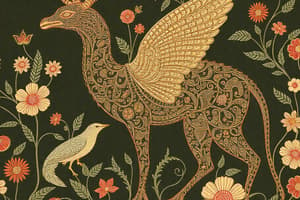Podcast
Questions and Answers
What is taxonomy?
What is taxonomy?
- The process of genetic selection
- The study of plant growth
- The science of classifying organisms (correct)
- The study of animal behavior
What defines a species?
What defines a species?
The basic grouping used in biological classification.
Not all members of a species look alike.
Not all members of a species look alike.
True (A)
What is inherited variation?
What is inherited variation?
What is polymorphism?
What is polymorphism?
What is geographic variation?
What is geographic variation?
What is individual variation?
What is individual variation?
What is the definition of a species?
What is the definition of a species?
How do species remain separate?
How do species remain separate?
What is one limitation of the species concept?
What is one limitation of the species concept?
What is a second limitation of the species concept?
What is a second limitation of the species concept?
What is a third limitation of the species concept?
What is a third limitation of the species concept?
What characteristics are used to classify organisms?
What characteristics are used to classify organisms?
What characteristics are the most useful in classifying animals?
What characteristics are the most useful in classifying animals?
Classification focuses on structures that indicate what?
Classification focuses on structures that indicate what?
What are structural resemblances called?
What are structural resemblances called?
What are examples of homologous structures?
What are examples of homologous structures?
What are structures that are similar in appearance and function, but not the result of shared ancestry called?
What are structures that are similar in appearance and function, but not the result of shared ancestry called?
What is an example of analogous structures?
What is an example of analogous structures?
Who developed the system used to classify organisms?
Who developed the system used to classify organisms?
What is used to group species in larger and more general categories?
What is used to group species in larger and more general categories?
What is the term for species with many similar characteristics?
What is the term for species with many similar characteristics?
What is the plural of genus?
What is the plural of genus?
What is family in biological classification?
What is family in biological classification?
What does the term order refer to in classification?
What does the term order refer to in classification?
What is a class in biological terms?
What is a class in biological terms?
What comes after class in biological classification?
What comes after class in biological classification?
What term do botanists replace phylum with?
What term do botanists replace phylum with?
What group are all animals classified in?
What group are all animals classified in?
Who changed Linnaeus's system?
Who changed Linnaeus's system?
After Darwin, classification became a way of describing what?
After Darwin, classification became a way of describing what?
What is binomial nomenclature?
What is binomial nomenclature?
The first word in binomial nomenclature is ____, the second is _____.
The first word in binomial nomenclature is ____, the second is _____.
What do together these two words form?
What do together these two words form?
What does phenetics compare?
What does phenetics compare?
What does phenetics give?
What does phenetics give?
What does phenetics not accommodate?
What does phenetics not accommodate?
Flashcards are hidden until you start studying
Study Notes
Taxonomy and Species
- Taxonomy is the science of classifying organisms based on their relationships and distinguishing characteristics.
- A species is a fundamental grouping in biological classification, defined as a population that breeds and produces fertile offspring under natural conditions.
- Inherited variation is the foundation of evolution.
Variation in Species
- Members of a species may exhibit differences in appearance; not all look alike.
- Polymorphism occurs when multiple forms exist within a single population.
- Geographic variation arises when a species spreads across diverse environments, leading to distinct physical traits.
Reproductive Isolation
- Species remain separate due to three main mechanisms:
- Lack of interaction among potential mates
- Mates interact but do not breed
- Mating occurs, but offspring are not viable or fertile.
Limitations of Species Concept
- The species concept has limitations, especially for organisms that reproduce asexually.
- Some sexually reproducing species may still have partial barriers to interbreeding.
- Slow, measurable changes in species over time challenge the applicability of the species concept.
Classification Characteristics
- Organisms are classified using structural, biochemical, behavioral, and genetic characteristics.
- Stable traits are crucial for animal classification, with structural features being particularly significant.
Structural Relationships
- Structural similarities that indicate a shared ancestry are known as homologies.
- Homologous structures, such as the flipper of a whale, bird wing, and human arm, arise from common ancestry.
- Similarities in appearance and function that do not derive from shared ancestry are called analogies, exemplified by moth and bird wings.
Classification System
- Carl von Linne, also known as Carolus Linnaeus, formulated the system for classifying organisms.
- Classification utilizes homologies to categorize species into broader groups.
- Species with similar traits are classified within the same genus, with the plural form being genera.
- Similar genera belong to the same family; distinctive animals are grouped in an order.
- Classes contain groups with basic similarities, such as mammalia for fur and milk-producing attributes.
- After class, organisms are sorted into phylum (or divisions for botanists).
- All animals fall under the kingdom Animalia.
Evolution and Classification
- Charles Darwin's work transformed Linnaeus's classification approach, correlating it with evolutionary relationships.
- Binomial nomenclature, established by Linnaeus, uses a two-word naming system (first word: genus, second word: species) to identify organisms.
Phenetics in Taxonomy
- Phenetics analyzes organisms based on a wide range of characteristics and assigns similarity scores based on shared traits.
- It treats all characteristics equally, although it may overlook important phylogenetic relationships.
Studying That Suits You
Use AI to generate personalized quizzes and flashcards to suit your learning preferences.




